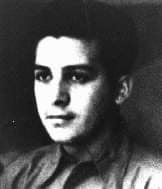"I was so weak that I could hardly stand," remembered Shony Alex Braun about his arrival at the Dachau concentration camp.
"I was so weak that I could hardly stand," remembered Shony Alex Braun about his arrival at the Dachau concentration camp.
As Allied forces advanced toward Germany in 1944–1945, the SS sent many Nazi prisoners to Dachau from other camps across occupied Europe, hoping that the camp's location in the German interior would prevent the capture of many prisoners on the front lines. Shony had survived Auschwitz and the Natzweiler concentration camp system before his transfer to Dachau.
One night, the SS guards took Shony, a talented violinist, from his barrack and demanded he play for them. Two other prisoners were also forced to play the violin. When the first prisoner began to play, he was struck by one of the SS officers and killed in front of Shony. The second prisoner refused and was also murdered.
Fearing for his life, Shony began to play "Blue Danube," a song he had never played before. "My right hand and my left hand all of a sudden started moving in perfect harmony," he recalled. The SS guards let Shony live.
As American forces neared Dachau in April 1945, Shony attempted to escape and was shot. When he regained consciousness, Shony was being treated by an American doctor. He had been liberated at Dachau #OnThisDay in 1945.
Many did not survive Dachau. At least 40,000 prisoners died there between 1933 and 1945.
After the war, Shony immigrated to the United States, where he became a successful composer and professional violinist.
Photo: USHMM, courtesy of Sandor Braun











Comments
Post a Comment